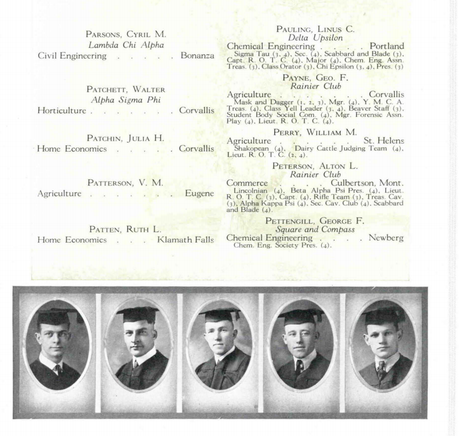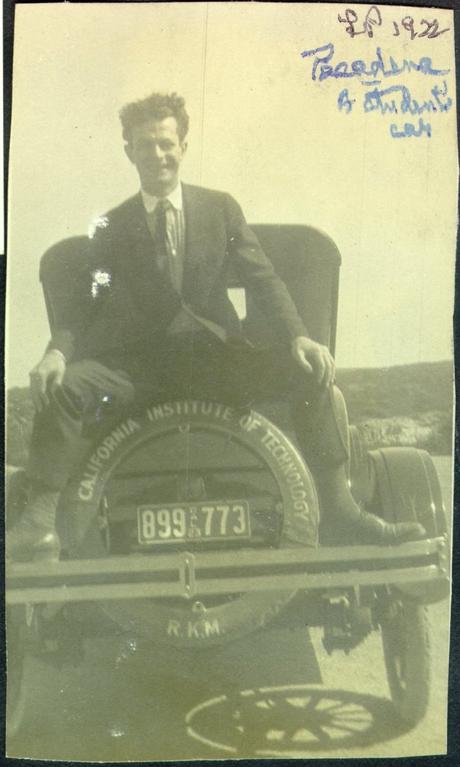
[Ed Note: School starts today here at Oregon State University! As we have for the previous four years, we take this opportunity to look back at Linus Pauling’s undergraduate experience in Corvallis, this time documenting his “super senior” experience as a Beaver.]
The 1921-22 academic year was Linus Pauling’s fifth at Oregon Agricultural College (OAC), now known as Oregon State University. In the twelve months to come, Pauling would finish his coursework; graduate; become engaged; and move to Pasadena, California to begin his graduate studies. Needless to say, it was a year of great change for Pauling, but one that he embraced with excellence.
In the fall of 1921, seniors at OAC were welcomed back to the college through a series of “Get Acquainted” dances, which were aimed at helping them become more comfortable with their apical position in the social hierarchy. Though these dances were a running tradition at OAC, each senior class approached them in their own way. During the 1921-22 academic year the dances were themed, with one particularly memorable event, the Goof Dance, challenging participants to wear the craziest outfits they had.
For Pauling, the start of the year marked a continuation of his effort to earn solid marks and gain entry into a good graduate program. Throughout his time at OAC, he had always applied himself, and by his senior year, those efforts were evident. As with other colleges, the OAC Beaver yearbook included basic information on all its seniors, as well as additional details documenting their participation in extracurricular organizations and clubs. These blurbs often consisted of a handful of words, but Pauling’s was, not surprisingly, several lines long.
As per OAC custom, Pauling’s entry lists his major (Chemical Engineering), his hometown (Portland), and his fraternal membership (Delta Upsilon). Other decorations included his membership in Sigma Tau, the engineering honor society into which he was inducted during his junior year and served as secretary during his final year at OAC. His participation in the Scabbard and Blade, a military honor society that he joined during his junior year, is also listed. During his senior year, Pauling served as a Captain in the Reserve Officer Training Corps, which was recognized by the yearbook as well. So too was he a member of the Chemical Engineering Association (junior year treasurer) and the Chi Epsilon civil engineering honor society (junior year president). His efforts in competitive speaking were noted as well.
Pauling’s accomplishments were likewise praised by outside organizations. One of them, the Oregon Alumni Society, heralded Pauling’s admittance into the Forum Honor Society, OAC’s most prestigious academic group. Pauling, along with sixteen other students, was admitted for his “excellence in scholarship, leadership in school activities and strength of character.” OAC President William Jasper Kerr welcomed the new members personally, a group that also included Pauling’s friend and future colleague, Paul Emmett.

Linus Pauling on OAC graduation day, June 1922.
" data-image-title="1922i.21" data-orig-file="https://paulingblog.files.wordpress.com/2014/06/1922i-21.jpg" data-image-description="" data-image-meta="{"aperture":"0","credit":"","camera":"","caption":"","created_timestamp":"0","copyright":"","focal_length":"0","iso":"0","shutter_speed":"0","title":""}" width="440" data-medium-file="https://paulingblog.files.wordpress.com/2014/06/1922i-21.jpg?w=170" data-permalink="https://paulingblog.wordpress.com/2014/06/19/think-independently-paulings-years-at-oac/1922i-21-2/" alt="" height="775" srcset="https://paulingblog.files.wordpress.com/2014/06/1922i-21.jpg?w=440 440w, https://paulingblog.files.wordpress.com/2014/06/1922i-21.jpg?w=85 85w, https://paulingblog.files.wordpress.com/2014/06/1922i-21.jpg?w=170 170w, https://paulingblog.files.wordpress.com/2014/06/1922i-21.jpg 703w" class="wp-image-6112" data-large-file="https://paulingblog.files.wordpress.com/2014/06/1922i-21.jpg?w=468" />Linus Pauling on OAC graduation day, June 1922.As graduation day neared, Pauling was asked to deliver the senior class speech. He was a likely choice to fill this role, given his strong academic standing and his success in a junior year debate contest. But unlike past years, where speakers tended to offer fairly generic observations, Pauling’s speech was notably more pointed.
Pauling viewed the speech as an opportunity for him to position himself as a scientist, and he focused his rhetoric on contemporary world events as observed through a scientific lens. A main thrust of the talk was his belief in scientists’ duty to use their tools for good. In exploring this, he referred to the scientific developments that had advanced weaponry options, including chemical weapons, during World War I. Pauling also expressed a feeling that science was being used to create income gaps and remove humanity from workspaces, before suggesting that “the country is crying for a solution to these difficulties, and is hopefully looking to the educated man for it.” This call to action was the real point of his talk, which ended with an exhortation to his classmates that they repay OAC in the years ahead through acts of service in their communities.

Newly arrived at Caltech, Pauling poses on the back of a student’s car.
" data-image-title="1922i.014-[1002]-300dpi-900w" data-orig-file="https://paulingblog.files.wordpress.com/2017/07/1922i-014-1002-300dpi-900w.jpg" data-image-description="" data-image-meta="{"aperture":"0","credit":"","camera":"","caption":"","created_timestamp":"0","copyright":"","focal_length":"0","iso":"0","shutter_speed":"0","title":"","orientation":"0"}" width="384" data-medium-file="https://paulingblog.files.wordpress.com/2017/07/1922i-014-1002-300dpi-900w.jpg?w=180" data-permalink="https://paulingblog.wordpress.com/2017/07/11/clothes-make-the-man/1922i-014-1002-300dpi-900w/" alt="" height="640" srcset="https://paulingblog.files.wordpress.com/2017/07/1922i-014-1002-300dpi-900w.jpg?w=384 384w, https://paulingblog.files.wordpress.com/2017/07/1922i-014-1002-300dpi-900w.jpg?w=768 768w, https://paulingblog.files.wordpress.com/2017/07/1922i-014-1002-300dpi-900w.jpg?w=90 90w, https://paulingblog.files.wordpress.com/2017/07/1922i-014-1002-300dpi-900w.jpg?w=180 180w" class="wp-image-18628" data-large-file="https://paulingblog.files.wordpress.com/2017/07/1922i-014-1002-300dpi-900w.jpg?w=468" />Newly arrived at Caltech, Pauling poses on the back of a student’s car.Pauling was well-aware of the need to move beyond OAC to continue his learning, and throughout the year the decision of where to go for graduate studies weighed heavily on his mind. Always keen on a future in chemistry, Pauling stayed current on recent developments in the field and knew that there were a handful of institutions equipped to provide him with an advanced education that could keep up with the changing times.
He decided to apply to four graduate programs: Harvard University, the University of California at Berkeley, University of Illinois, and the California Institute of Technology. Of these schools, Pauling was perhaps most attracted to Berkeley because it was headed by G.N. Lewis, who had discovered that electron bonds are shared. Harvard was also enticing, in part because its program was led by Theodore Richards, who was America’s only Nobel Laureate in chemistry at the time. Richards had attended the University of Illinois for his graduate work, and this connection had helped to boost its program. Caltech, by comparison, was the smallest and newest of the possibilities in which Pauling was interested.
Pauling eventually opted for Caltech, a decision that was made, in part, because of a fortunate sequence of events. All of the universities that Pauling wanted to attend were interested in him, and Harvard offered an attractive fellowship that would cover his tuition. But shortly after receiving this offer, Caltech’s letter arrived. Like Harvard, the Pasadena school offered a full-ride fellowship, but Caltech’s package also included a $350 stipend to work as a teaching assistant in undergraduate chemistry courses. Importantly, Caltech had also accepted Pauling’s close friend, Paul Emmett, and the two would ultimately live together for their first year as graduate students. These two factors tilted the scale in Caltech’s favor, and Pauling would remain at the Institute for more than forty years.
